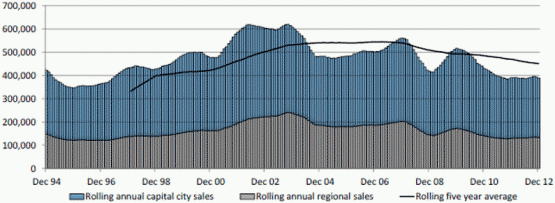Some 65.9% of all house and unit sales in 2012 were within capital cities, with the number of houses and units sold in capital cities last year dropping to 256,559. It’s the lowest level of transactions for established properties since 1996, according to RP Data analyst Cameron Kusher.
There was a slight bounce back in sales activity in the second half of the year, in which sales were 7.6% higher than the first; Kusher reckons the increase in activity reflected the delayed impact of mortgage rate cuts over the past 12-18 months and improving consumer sentiment.
And it’s mirrored in the increase in capital city home values from June 2012 onwards. “A stable interest rate environment and a sustainable improvement in consumer sentiment would increase the likelihood of further increases in buyer demand throughout 2013,” he said.
Sales activity rose in Brisbane, Perth and Darwin, pointing to stronger housing markets in those cities in 2013. In Perth, the number of sales jumped by 25%. Sydney, which accounted for 27% of all Australian house sales, recorded a 12% decline in sales, while in Melbourne the decline was 5%.
Rolling annual number of house and unit sales (capitals v regional markets)

Annual number of house and unit sales (capitals)

The figures don’t include the sale of off-the-plan apartments that have not been settled. Some 72.4% of all sales in 2012 were for houses.
Across Australia there were 389,069 house and unit sales over the year, according to RP Data estimates. Nationally, sales were 0.3% lower than in 2011 and 13.7% lower than the five-year average level. “Nationally, annual sales volumes have not been this low since 1996,” Kusher said.
Sales transactions have increased over the past year in Brisbane, Perth and Darwin. But in Sydney, annual sales volumes haven’t been this low since 2005; in Melbourne, Adelaide and Canberra sales transactions haven’t been this low since 1996, and the last time Hobart sales were lower was in 1988.
“While transaction activity remains at such low levels it does not bode well for any significant increase in home values,” Kusher said.
*This article was originally published at Property Observer







Sydney has just over 20% of the Australian population, Brisbane just under 10%. You would never dream of leaving this 30% of the population out of your analysis – but we don’t get any information on the 33.1% of house and unit sales not in the capital cities.
The failure of the Labor federal government to provide real estate capital gains to voters in the manner to which they became accustomed in the Howard Golden era is likely to urderpin the election of an Abbott government.
Ironically, that $TRILLION Howard era Mortgage time bomb remains buried in the Australian economy despite every effort of the Labor federal adminstrations to defuse it.
Can any property experts surveying this prospect explain how the coming Abbott Austerity, already entrenched by the policies of his conservative state counterparts, will not raise interest rates, as his would-be treasurer Joe Hockey requires and depress property values even more?
Add the mass sackings in pursuit of reducing the Federal debt, which is just25% of overall private mortgage debt and Australia, to the dismay of overseas investors, will punge into the “GFC it had to have”.
Yet the industry continues its blind loyalty to the myth of conservative economic competence, despite all evidence to the contrary.
Time, boys and girls to start sending the message to the Mainstream Media to lay off the present government, or the $TRILLION Howard era mortgage time bomb will blow up in your faces.
The truth hurts?
What will you be doing in the Abbott Recession?